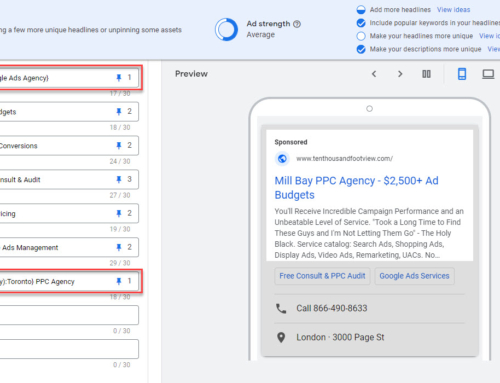In this continuing series for specific industries, I’m covering Google Ads for Home Buyers in this article. For clarity, home buyers are often referred to as “house flippers” and most are in the business of buying homes, fixing them up, and selling them for a profit. However, that’s not the only business model for home buyers as I’ll describe later on.
We work with several clients in this niche and have been running home-buying campaigns for over 8-years.
DISCLOSURE: Some of the products mentioned in this post may contain affiliate links that at no additional cost to you, we may earn a small commission. Importantly, we only promote products that we use ourselves.
Before going any further, here are a few words about the scope and constraints of this post.
Scope & Constraints
The strategies and tactics outlined are broadly applicable to most advertisers that buy homes for the purpose of flipping them. However, every business is unique, and hence every Google Ads implementation needs to be as well. This article, alone, shouldn’t be the basis for building and optimizing your Google Ads campaigns. You should always work with an experienced Google Ads expert or take comprehensive training before making this type of investment.
Industry Description
Home-buying companies include any business that:
- buys undervalued homes and resells them immediately without any improvements
- buys and fixes up and then flips (resales) homes for a quick profit
- buys and rents homes, holding on to them to build equity
- provides a platform to match sellers with buyers
In essence, this alternative real-estate market offers sellers an opportunity for a quick no-hassle sale.
The house flipping industry grew tremendously over the past decade as many “gurus” sold courses for DIYs to get into the game. On the high end, there are US national companies such as HomeVestors, Simple Sale, We Buy Houses and others. There are regional players that cover one or more states and handle dozens of properties. And there are the mom-and-pop operators that typically only have 1-2 properties in their inventory at any given time.
For a more detailed industry breakdown check out this article from HomeLite.
Google Ads Eccentricities
In this section, I’ll cover some specific things you need to be aware of when running Google Ads for home buyers.
Personalized Advertising Restrictions for Housing
In 2020 Google imposed targeting restrictions for housing, employment, and credit. This was put in place to protect certain demographic groups from being excluded from advertising. This prevents real estate advertisers from targeting by gender, age, parental status, marital status, or ZIP code.
This means you cannot use any of the demographic targeting options except for, oddly, income level. As for zip code targeting, while it is forbidden, you can actually translate zip codes to geo coordinates and effectively do the same thing. There are a number of free and paid tools online that will help you do this if you desire.
If any of your campaigns get flagged or suspended you can fix that simply by removing the offending targeting and then resubmitting the campaign for review through Google’s policy manager.
Trademark Protection
Several major home-buying companies aggressively defend their brands. At my agency, we don’t subscribe to passing off our clients as other brands. But many advertisers in this niche do just that to try to gain an edge. I strongly advise against using your competitors’ brands in creative, on landing pages, or using similar language/jargon to appear to be a different company.
You will receive a cease and desist letter pronto and then have to decide whether you want to waste time and money on legal defence for the next couple of years.
Search Campaigns
Paid search lead generation campaigns are the bread and butter for home-buying companies.
You should structure campaigns into major geographic regions for budget control. Campaigns should also be separated into topics and branded. Topical ad group themes should include high-precision keywords [sell my house fast], keywords with location qualifiers [sell my house in Houston], and competitor brands [Houston Home Buying Group].
Start with phrase and exact match keywords and ensure you use qualifiers to avoid running to adjacent markets or the wrong audience. For example, you should avoid people looking for a regular realtor, people interested in buying, and those looking to learn how to flip homes.
Even more important is the negative keyword strategy. You absolutely must try to block the following categories of irrelevant queries:
- real estate
- agent
- for sale
- loan, lending, mortgage
- grant
- and many others… I’m not giving away all of our secrets
While it is possible to consider some of these as broader / higher up the funnel, budgets get eaten up fast, and there are better ways to get in front of potential sellers as I’ll discuss later.
As with any search campaign, ensure you fully utilize your RSA ad copy slots and add all applicable assets (formally called ad extensions). One unfortunate thing about this niche is that all competitors tend to offer identical features and benefits. It’s very hard, therefore, to distinguish your ads from the other guy.
You will routinely see these main benefits:
- fast guaranteed sale
- easy process
- get paid in cash
- avoid agent and other fees
- instant or quick turnaround offer
Most advertisers will also use trust factors to pitch:
- in business for “x” years
- “x” number of homes purchased
- see our testimonials
- BBB Accredited
- As seen on ABC, NBC, etc. (this is actually just from using a press release service)
At my agency, we try to focus on developing a “language” that’s specific to each client. While the benefit may be similar to others we will try to say it in a unique way and then use that language consistently as part of brand identity.
The CPC for quality keywords is typically pretty high for home buyers, so very small budgets don’t tend to work very well. If you can’t spend at least $2-3K/month you are probably going to find it difficult to get to a stage where you can leverage automated bidding. Also, even if you can get the 15-25 leads per month to facilitate automation, that may not be enough volume to generate even a single purchase. Realistically, think $5K+ to run Google Ads effectively in house flipping.
Remarketing Campaigns
In this niche, you typically have about a 90-day max window to convert somebody looking to sell. We will generally create and run 7-day, 30-day, 60-day, and 90-day remarketing lists. It can also be worth segmenting people that have visited your web form pages (if those are not built into your landing page).
On the creative front, I strongly recommend using unique imagery. Worst case you should buy stock photos, don’t use free downloadable stock as smaller players often use that content. Ideally, you should shoot photos of your own houses and/or happy clients you’ve worked with. One other option you might explore is AI-generated imagery. We’ve started using this for some client work. The state-of-the-art paid option is Midjourney, but we also have early access to Leonardo.
We have all but stopped running remarketing ads on the Google Display Network (GDN) and have adopted Discovery Ads as our standard. The inventory is much higher quality and generally not subject to issues with iOS-blocked devices. Note that to target lists directly with Discovery requires using the Google Ads Editor at the moment. And it’s likely that loophole will be going away soon. Feel free to run on GDN, just manage your placements carefully to avoid quality and click fraud issues.
Also, don’t forget to create a list of converted users and exclude them from targeting.
Performance-Max Campaigns
Once you establish high-performing search campaigns you should expand your reach with P-Max. Performance-Max campaigns will find incremental search conversions and work up the funnel which can lower your CPAs and improve efficiency back in your search campaigns. I’ve written a guide on how to set up P-Max which is applicable here.
Make sure you have enough budget here to get at least 25 conversions/month, otherwise, this campaign might flame out on you.
As always, I strongly recommend running branded search in a separate search campaign. If you don’t want to run branded at all you should block all of your brand variations with the account-level negative keywords tool.
Also, as per above, consider adding your primary negative keywords (up to 1,000) to your account level negatives list. This will block matching queries and placements across all campaigns including P-Max, display, search, and video.
Other Campaign Types
If you have a large enough account budget (around $25K/month+) you may want to run video, discovery, and display separately from P-Max. Just keep in mind that while you will gain better insights and more campaign control, you might find that overall performance dips. These campaigns should be geared more towards pure branding and influencing decision-making goals, don’t measure their individual success by CPA!
Campaign Optimization Notes
The home buying niche requires more frequent search terms reviews than most markets. I touched on this in the “search campaigns” build above, but it’s worth saying again. You’ll face a wide range of irrelevant queries that will eat a ton of budget if you’re not careful. Be sure to look for low CTR, low-converting, and high CPA queries to block.
This type of account is a perfect candidate for the N-Grams script. This script will help you identify low-performing root words and greatly expedite/simplify negative keyword list building.
If you aren’t able to drive enough conversions through a single campaign to switch to automated bidding you should consider portfolio bidding. Portfolio bidding will treat included campaigns as a single entity. Just remember this is only appropriate if you’re okay with getting a lot of leads from one campaign at the expense of another in the same portfolio.
Tools and Other Tips
Since many leads tend to come in via inbound calls you absolutely must use a 3rd party call tracking service of some sort to record these as conversions. We are a CallRail partner and love the low starting price point, simple implementation, and ability to expand to include form tracking for full sales-funnel analysis.
As soon as you can you should consider switching from ECPC to tCPA or Max Conversions bidding. We have been able to move some of our clients over to a value-based bidding strategy that takes performance to the next level. One way to do this is by tracking leads in a service such as CallRail and scoring them with relative values such as $0 for spam, $100 for valid leads, $250 for qualified leads, and $1,000 for completed deals. Note that you only have a 90-day window to edit values, which can be a bit of a problem in the real estate market.
Even if you don’t do that, just “qualifying” leads in CallRail can improve performance substantially.
Summary
Home-buying companies face a few unique challenges when it comes to Google Ads. If you can navigate personalized advertising restrictions and maintain precision keyword targeting your campaigns will prosper. Just as important is to offer distinctive ad copy to stand out from the crowd.
Lastly, home flippers tend to get a lot of spam leads. Using a tool such as CallRail to qualify leads can improve data quality and enhance conversion performance over time.






